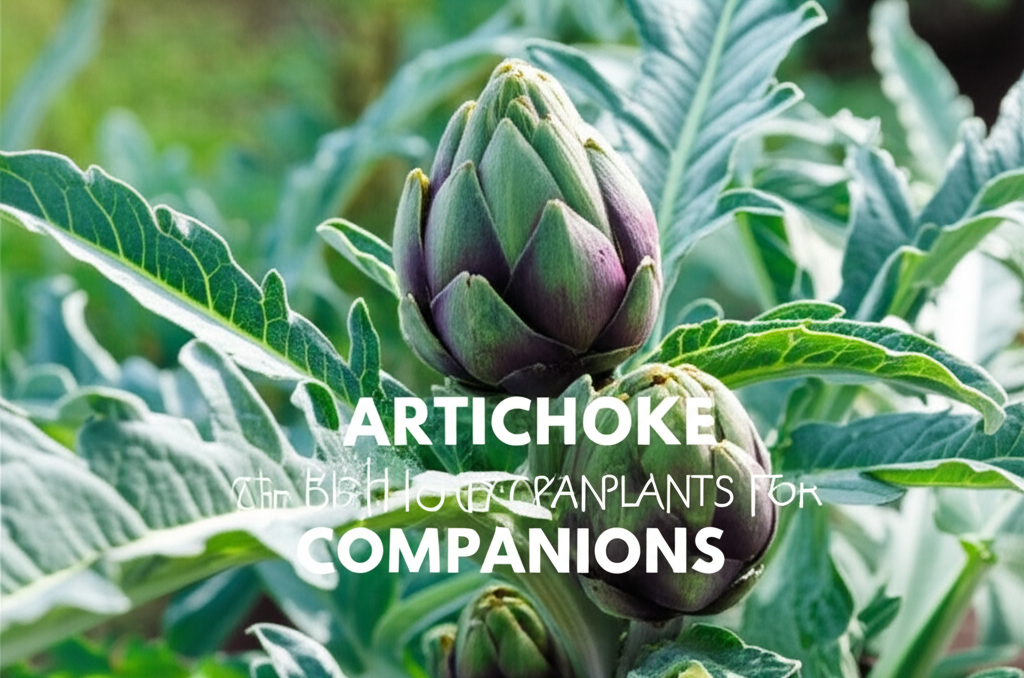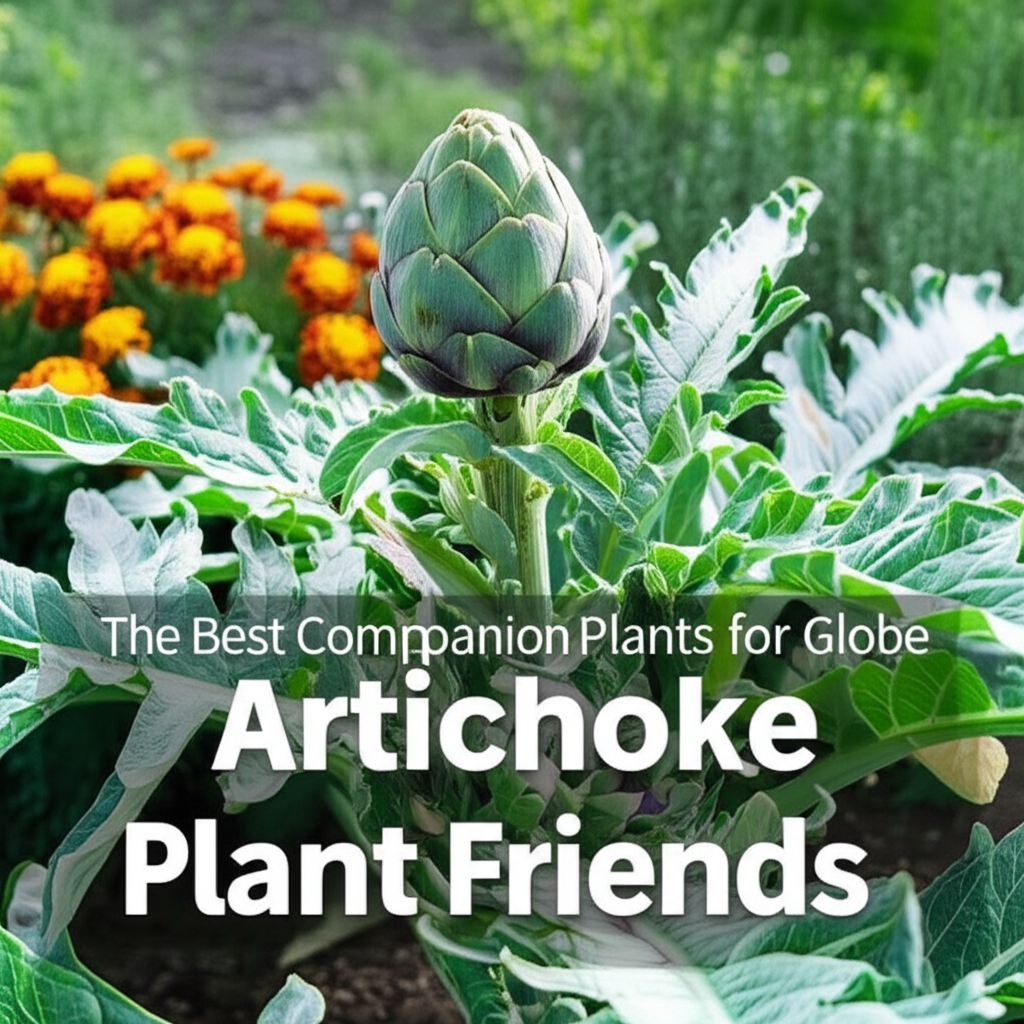Globe artichokes (Cynara cardunculus var. scolymus) are magnificent, architectural plants that reward gardeners with delicious, edible flower buds. However, like any living organism, they benefit from a supportive cast of characters in the garden. Companion planting, the practice of strategically placing plants together to promote growth, deter pests, and improve overall garden health, is particularly beneficial for globe artichokes. Choosing the right companions can transform your artichoke patch into a more robust, productive, and pest-resistant ecosystem. This guide explores the best companion plants for globe artichokes, delving into the science and benefits behind these symbiotic relationships.
Why Companion Planting Matters for Globe Artichokes
Globe artichokes are relatively hardy plants, but they aren’t immune to the challenges of the garden. They can be susceptible to certain pests, such as aphids, slugs, and artichoke plume moths. Additionally, their substantial size and nutrient demands mean they can sometimes compete with neighboring plants. Companion planting addresses these issues by leveraging natural interactions:
- Pest Deterrence: Certain plants emit scents or possess properties that repel common artichoke pests.
- Beneficial Insect Attraction: Other plants draw in predatory insects or pollinators, creating a more balanced ecosystem.
- Nutrient Enhancement: Legumes, for instance, fix nitrogen in the soil, which can be beneficial for heavy feeders like artichokes.
- Soil Improvement: Some plants can help break up compacted soil or add organic matter.
- Space Utilization: Taller plants can provide shade for smaller, more delicate companions, or vice-versa.
- Disease Prevention: Certain plants can have antimicrobial properties.
Top Companion Plants for Globe Artichokes

The ideal companions for globe artichokes complement their needs without competing excessively. Here are some of the most effective choices:
1. Legumes (Beans, Peas)
Legumes are stellar companions for globe artichokes due to their remarkable ability to fix atmospheric nitrogen into the soil through a symbiotic relationship with Rhizobium bacteria. Globe artichokes are heavy feeders, and the nitrogen provided by legumes can significantly boost their growth and bud production.
Benefits:
- Nitrogen Fixation: Provides a natural fertilizer, reducing the need for external nitrogen inputs.
- Soil Aeration: Their root systems can help break up compacted soil.
- Pest Deterrence: Some bean varieties are thought to deter certain soil-borne pests.
Considerations:
- Plant bush beans or dwarf peas around the base of established artichokes, ensuring they don’t shade out the artichoke’s lower leaves.
- Avoid planting pole beans too close, as their vigorous growth might overwhelm the artichoke.
2. Aromatic Herbs (Rosemary, Sage, Thyme, Oregano)
The strong scents emitted by these herbs are a significant deterrent to common artichoke pests like aphids and slugs. Their presence creates a fragrant barrier that can confuse and repel insects.
Benefits:
- Aphid Deterrence: The pungent aromas mask the scent of artichokes, making them harder for aphids to find.
- Slug Repellence: Some herbs, like rosemary, have a rough texture that slugs dislike crawling over.
- Attracts Pollinators: Flowering herbs can draw in bees and other beneficial pollinators.
- Culinary Synergy: Many of these herbs are also excellent culinary companions to artichokes.
Considerations:
- Plant these herbs around the perimeter of the artichoke patch or intersperse them between plants.
- Ensure adequate spacing to prevent overcrowding.
3. Nasturtiums
Nasturtiums are renowned as excellent “trap plants” or “sacrificial plants.” Their bright, attractive flowers and tender leaves are highly appealing to aphids, drawing them away from your artichokes.
Benefits:
- Aphid Trap: Concentrates aphids onto the nasturtium, making them easier to manage or remove.
- Deters Whiteflies and Squash Bugs: Also effective against other common garden pests.
- Edible Flowers and Leaves: Adds a peppery note to salads and dishes.
Considerations:
- Plant nasturtiums liberally around your artichokes.
- Once infested with aphids, you can prune them off or even remove and dispose of the plant to break the aphid lifecycle.
4. Marigolds
French marigolds (Tagetes patula) are famous for their ability to deter nematodes in the soil, microscopic roundworms that can damage plant roots. While not a primary concern for all artichoke growers, nematicidal properties are always a welcome addition. They also deter other pests like whiteflies and are believed to deter cabbage worms, which can sometimes affect artichokes.
Benefits:
- Nematode Control: Roots release compounds that kill soil nematodes.
- Pest Repellent: Deters whiteflies, aphids, and cabbage worms.
- Attracts Pollinators: Certain varieties can attract beneficial insects.
Considerations:
- Plant marigolds along the edges of the artichoke bed or intersperse them.
- Choose French marigolds for their stronger nematicidal properties.
5. Garlic and Onions (Alliums)
Alliums are powerful pest deterrents due to their strong scent and sulfur compounds. They are effective against a wide range of pests, including aphids, slugs, and certain beetles.
Benefits:
- Aphid and Slug Repellent: Their pungent odor deters many common pests.
- Deters Root Maggots: Can help protect the artichoke’s root system.
- Disease Prevention: Some alliums have antifungal properties.
Considerations:
- Plant garlic cloves or onion sets around the base of artichoke plants.
- Their shallow root systems are unlikely to compete significantly with artichokes.
6. Borage
Borage is a fantastic companion for attracting pollinators, especially bees, which are crucial for the health and yield of many plants, including artichokes (though artichokes are primarily wind-pollinated, increased pollinator activity benefits the overall garden ecosystem). Borage is also said to deter tomato hornworms and improve the flavor of strawberries, and its composted leaves add valuable trace minerals to the soil.
Benefits:
- Pollinator Attraction: Draws bees and other beneficial insects to the garden.
- Pest Deterrence: Said to deter tomato hornworms and other pests.
- Soil Amendment: Decomposes to add trace minerals.
Considerations:
- Plant borage a little distance from the artichokes to avoid overwhelming them with its growth.
- It readily self-seeds, so manage its spread if necessary.
Plants to Avoid Planting Near Globe Artichokes
While many plants are beneficial, some can hinder the growth of globe artichokes or attract unwanted pests.
1. Brassicas (Cabbage, Broccoli, Kale)
Brassicas are heavy feeders and can compete with artichokes for nutrients and water. They also attract similar pests, such as cabbage worms and aphids, which could easily transfer to your artichoke plants.
2. Potatoes
Potatoes are known to deplete soil nutrients, particularly potassium, and can be susceptible to blight. Planting them near artichokes could lead to nutrient competition and potential disease transmission.
3. Fennel
Fennel is a well-known allelopathic plant, meaning it can inhibit the growth of many other plants. It’s best to give artichokes their own space and avoid planting fennel nearby.
Key Facts and Comparison of Companion Plants
Here’s a quick reference to the benefits and considerations for each recommended companion plant:
| Companion Plant | Primary Benefit for Artichokes | Secondary Benefits | Considerations |
|---|---|---|---|
| Legumes (Beans, Peas) | Nitrogen fixation | Soil aeration, pest deterrence | Bush varieties best, avoid overcrowding |
| Aromatic Herbs (Rosemary, Sage, Thyme) | Aphid and slug deterrence | Pollinator attraction, culinary synergy | Plant around perimeter or interspersed |
| Nasturtiums | Aphid trap plant | Deters whiteflies/squash bugs, edible | Plant liberally, manage aphid buildup |
| Marigolds (French) | Nematode control | Deters whiteflies, cabbage worms | Plant along edges or interspersed |
| Garlic/Onions (Alliums) | Pest deterrence (aphids, slugs) | Deters root maggot, antifungal | Plant around base, shallow roots |
| Borage | Pollinator attraction | Pest deterrence, soil amendment | Plant slightly apart, self-seeds |
Companion Planting Strategies for Artichokes
Implementing companion planting effectively requires thoughtful placement and consideration of plant growth habits.
1. Perimeter Planting
Planting deterrent herbs like rosemary, sage, and garlic around the outer edge of your artichoke bed creates a fragrant barrier that can help keep pests away.
2. Intercropping
Placing smaller, beneficial plants like nasturtiums, marigolds, or bush beans directly between artichoke plants can maximize space and provide immediate benefits. Ensure there’s adequate airflow and light for both plant types.
3. Succession Planting
Consider planting fast-growing companions like radishes or lettuce that can be harvested before the artichokes become too large, thus avoiding competition for resources.
4. Crop Rotation
While not strictly companion planting, rotating where you plant your artichokes and their companions each year is crucial for soil health and pest management. Avoid planting artichokes in the same spot year after year, and follow them with plants that have different nutrient needs and pest vulnerabilities.
Pros and Cons of Companion Planting with Globe Artichokes
Companion planting offers numerous advantages but also comes with a few considerations.
| Pros | Cons |
|---|---|
| Enhanced Pest Management: Natural deterrence and attraction of beneficial insects reduce reliance on chemical pesticides. | Competition for Resources: If not planned carefully, companions can compete with artichokes for light, water, and nutrients. |
| Improved Soil Health: Legumes fix nitrogen, and others can improve soil structure and fertility. | Increased Complexity: Managing multiple plant types requires more attention to watering, feeding, and spacing. |
| Increased Biodiversity: Attracting a variety of insects and beneficial organisms creates a more resilient ecosystem. | Potential for Pests to Transfer: While some companions deter pests, others might inadvertently attract pests that could then move to the artichokes. |
| Maximized Space Utilization: Strategic planting can make efficient use of garden space. | Slower Growth for Companions: Some companion plants might experience slower growth if their needs are not fully met due to the artichoke’s larger size. |
| Aesthetic Appeal: Colorful flowers like nasturtiums and marigolds add beauty to the artichoke patch. | Learning Curve: Identifying the best companions and optimal planting arrangements can take time and experimentation. |
Conclusion
Globe artichokes are a rewarding addition to any garden, and by employing smart companion planting strategies, you can significantly enhance their health, productivity, and resilience. By carefully selecting companions like legumes for their nitrogen-fixing capabilities, aromatic herbs and alliums for pest deterrence, nasturtiums as aphid traps, marigolds for soil health, and borage for pollination, you can create a thriving, balanced ecosystem. Remember to avoid plants that compete heavily for resources or attract similar pests. With a little planning and observation, your globe artichoke plants will flourish, providing you with a bountiful harvest of these delicious and striking vegetables. Happy gardening!


